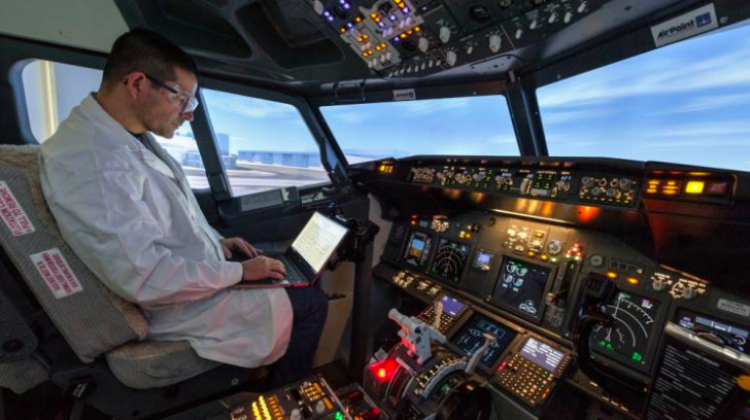Airlines learn about the birds and the bees... to save money
 Collaboration of Warsaw and Columbian scientists resulted in the creation of software that optimises the routes of passenger aircrafts, significantly inspired by social behaviour of insects and birds. Image courtesy of AirPoint Flight Simulator Experience. Source: Institute of Physical Chemistry PAS, Grzegorz Krzyżewski
Collaboration of Warsaw and Columbian scientists resulted in the creation of software that optimises the routes of passenger aircrafts, significantly inspired by social behaviour of insects and birds. Image courtesy of AirPoint Flight Simulator Experience. Source: Institute of Physical Chemistry PAS, Grzegorz Krzyżewski
Polish-Colombian team of scientists created software that allows to rationally modify passenger aircraft flight routes in real time. It allows to save a lot of money - researchers argue. The inspiration came from... insects and birds.
The features of the animated world, verified by millions of years of evolution, inspired a team of scientists and engineers from the Institute of Physical Chemistry PAS (IPC PAS) in Warsaw and Universidad Cooperativa de Colombia (UCC). According to the IPC PAS, they worked together on optimising flight routes of airplanes. The objective was to reduce greenhouse gas emissions, environmental pollution by noise, and operating costs of machinery. The result are algorithms that reflect the characteristic features of behaviour of... bees and cuckoos.
"In Warsaw, we mainly deal with catalysis" - says Dr. Juan Carlos Colmenares (IPC PAS). "Recently, it turned out that methods inspired by solutions found in nature can be applied in the analysis of catalytic problems" - he notes.
"We wondered if we could use our knowledge to optimise fuel combustion in aircraft engines. With partners from Colombia, we started to work on one module, but the program began to grow rapidly to include more modules, taking into account other factors that affect the shape of routes" - he adds.
The software developed over three years has been designed to determine optimal routes for short-distance aircrafts equipped with turbo-ventilator engines with a constant combustion volume. In this group, each type of aircraft is represented by a corresponding set of parameters. In the future, researchers plan to expand the software with algorithms and data taking into account the specific characteristics of aircrafts with engines of other types.
The software already takes into account a whole range of parameters, related not only to the type of fuel, engine performance or aerodynamics, but also factors such as originally assumed shapes of routes, climb and descend profiles, lengths of airport runways and local topography. Environmental and chemical emission modules deal with environmental impact optimisation. The package meets the safety standards imposed by the International Civil Aviation Organization (ICAO).
According to the press release, the heart of the software are two algorithms for finding potential routes. The basic algorithm uses patterns observed in nature in group movements of animals, especially in schools of fish or swarms of bees. Each individual in the group decides about the next movement based on the current knowledge of the best places visited by that individual and other individuals in the group, and takes into account the inertia of its own movement. In the flight route optimisation package, "bees" are various points around the aircraft, each of them treated as a separate individual penetrating the area. The algorithm begins its work from a "swarm" of points moving around the aircraft. In the next repetitions of the algorithm, "bees" begin to group around the most optimal place at a given moment, and this place is considered the next stage of the flight route.
The second algorithm that searches for the next stage of the flight imitates the behaviour of the cuckoo, the bird that lays its eggs in the nests of other species. Routes designed using the cuckoo algorithm are characterized by long, straight sections and 90 degree turns.
"The great advantage of our software is that it works in real time" - emphasises Dr. Colmenares. "As a result, the flight controller and the pilot receive updated hints. They can not only decide quickly, but also consciously, choosing between a slightly more risky but more economical route, and a safer but a little longer route" - he says.
To test the software, the researchers analysed the effectiveness of its predictions for the popular Airbus A320 aircraft with CFM56-5 engines, flying on routes around 350 km, with typical flight parameters (flight speed 828 km/h, ceiling 39370 feet, etc.). Simulations show that in unconventional situations, the routes proposed by the software were, on average, about 11 km shorter than the typical alternative ones, calculated in the traditional way on the basis of the flight plan. Ultimately, the optimisation allowed to reduce the total operational costs of one machine by 1.16 percent.
"Savings at a level slightly above one percent do not look particularly great, but our simulations show that even for one, often operated aircraft, savings per year can reach hundreds of thousands of dollars" - emphasises Dr. Ramón Fernando Colmenares-Quintero (UCC). "And our software is still in development and not yet fully optimised! In the future we can expect slightly higher savings than those currently forecasted, but we should not expect any miracles" - he adds.
In the coming years, the individual parts of the package optimising flight routes will be improved, and the package itself will be expanded with new modules. Polish-Colombian research on this topic is financed by the Universidad Cooperativa de Colombia with the support of the Colombian Instituto Tecnológico Metropolitano.
PAP - Science in Poland
kflo/ ekr/ kap/
tr. RL
Przed dodaniem komentarza prosimy o zapoznanie z Regulaminem forum serwisu Nauka w Polsce.














